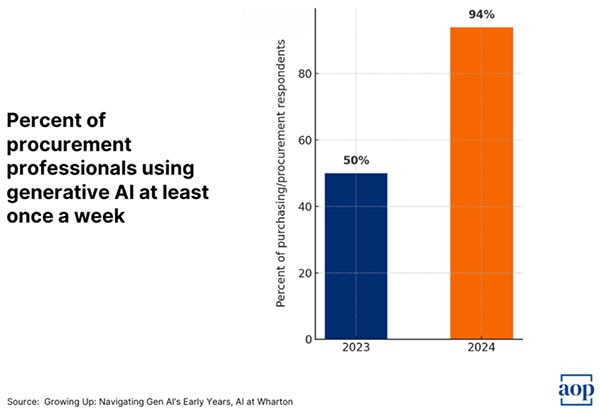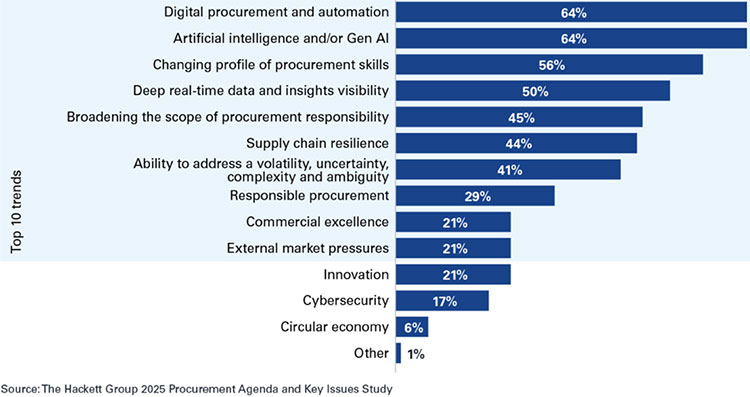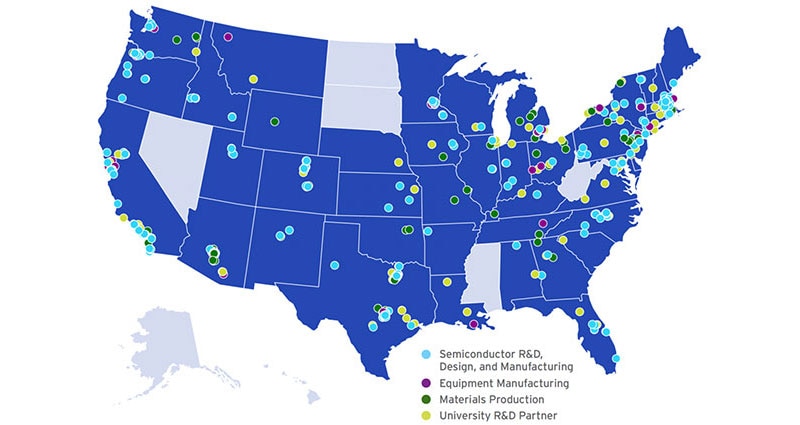Beyond Efficiency: Procurement's AI Imperative
The global electronics supply chain, characterized by intricate value networks, rapid technological advancements, and persistent and seemingly endless volatility, stands at a critical juncture. Economic pressures are mounting, and the geopolitical landscape is shifting, creating pressure for a swift evolution in the role of procurement. Once hired as maintainers of cost efficiency, procurement professionals are increasingly becoming strategic enablers of resilience, innovation, and competitive advantage. The accelerating adoption of artificial intelligence (AI) and generative AI (Gen AI) is poised to fundamentally reshape how procurement impacts the supply chain, driving unprecedented changes in operations, talent, and decision-making.
The widening AI gap
Despite the revolutionary potential of AI, many procurement organizations are still lagging behind their suppliers in AI readiness and adoption, according to Fairmarkit research.1 A whopping 84% of procurement leaders believe a recession is underway or imminent by the end of 2025, intensifying cost pressures and exposing the widening gap in AI capabilities.
While 94% of procurement leaders report that their suppliers are already leveraging AI in negotiations, a significant portion of procurement teams harbor concerns about relying on potentially inaccurate or incomplete AI-generated data (43%) and the risk of being locked into unfavorable deals (39%). This disparity highlights an urgent need for procurement to treat AI as a core strategic initiative, rather than a back-burner activity.
AI's transformative impact on supply chain dynamics
Procurement professionals are recognizing this need. The Art of Procurement drew data from Wharton research on AI, which showed that the weekly use of Gen AI for purchasing and procurement increased by 44% from 2023 to 2024, at which point 94% of respondents were using Gen AI at least once per week (Figure 1).2 That was 2024; much has undoubtedly changed since then.
 Figure 1 : The weekly use of Gen AI for purchasing and procurement reached 94% in 2024. (Image source: Art of Procurement)
Figure 1 : The weekly use of Gen AI for purchasing and procurement reached 94% in 2024. (Image source: Art of Procurement)
Indeed, AI procurement technologies offer a multifaceted approach to navigating market complexities. For many current procurement professionals, AI tools can help streamline various mundane business tasks, including answering request for proposal (RFP) questions, drafting contracts, and developing project scope documents. Meanwhile, AI technology is being increasingly embedded in procurement tools to offer a range of features, including chatbots that answer stakeholder questions, as well as autonomous sourcing and negotiation tools.
A handful of opportunities stand out as being particularly impactful in terms of the ways that generative AI can and ultimately will enhance the electronics procurement segment:
- Enhanced demand forecasting & inventory optimization: AI has revolutionized demand forecasting by moving beyond traditional reliance on historical sales data. Instead, AI can analyze vast amounts of data, including market trends, social media buzz related to products, and real-time information, to provide predictions with measurable accuracy.3 This capability is crucial for the electronics supply chain, where rapid technological cycles and fluctuating consumer demand can lead to significant overstock or stock-out issues.
- Strategic sourcing & supplier management: AI-powered tools have the potential to enhance every stage of the sourcing process. They can automate document generation, forecast demand, evaluate suppliers, optimize pricing, boost efficiency, and streamline decision-making. Of course, not all activities can be completely automated. Some AI functions can be used to expedite the processing and understanding of information. For example, an AI assistant might develop a structured scope document based on a series of more informal requirements or analyze incoming RFP responses to do initial scoring on potential new partners. Furthermore, AI supports effective supplier management by enabling proactive supplier monitoring, risk assessment, and identification of new potential suppliers or opportunities for consolidation.
- Proactive risk mitigation & supply chain resilience: In a world marked by ongoing disruptions and geopolitical shifts, AI supports a greater focus on risk management. AI algorithms can monitor supplier financial health, geopolitical developments, and market signals to provide an organization with early warning signs of emerging risks. For instance, AI systems can automatically map spend data against tariff codes and country-of-origin information, providing immediate visibility into exposure, modeling cost implications across different scenarios, and prioritizing mitigation strategies within minutes.4 This ability to conduct sophisticated scenario planning and “what-if” analysis enables procurement professionals to manage supply chain vulnerabilities and proactively ensure supply continuity.
- Driving efficiency & cost reduction: The immediate benefits of AI adoption include substantial efficiency gains and cost reductions. AI automates routine tasks such as purchase order processing, spend data cleansing, and contract creation, freeing procurement teams to focus on higher-value, strategic initiatives. Early adopters have observed productivity improvements up to 10%, with some cases exceeding 25%. Critically, AI can reduce overall procurement costs by 15 to 45% and eliminate up to 30% of current work activities by augmenting human analytical capabilities and reducing human error.5 As a result, 64% of procurement professionals expect Gen AI to fundamentally change how their teams operate in the next five years (Figure 2).
 Figure 2 : Nearly two-thirds (64%) of procurement executives anticipate that Gen AI will fundamentally change how their teams operate within the next five years. (Image source: The Hackett Group)
Figure 2 : Nearly two-thirds (64%) of procurement executives anticipate that Gen AI will fundamentally change how their teams operate within the next five years. (Image source: The Hackett Group)
The downside of AI
Many organizations and their procurement professionals are eager to adopt AI, recognizing the potential benefits that the technology offers. To be successful, though, these leaders must learn to think differently about their work and to carefully consider where Gen AI can assist and augment human tasks.
Several barriers currently hamper widespread AI adoption. As with any technology transformation, the system is only as good as the data it is given. Currently, most organizations store their data in various formats, lacking comprehensive historical information and standardized taxonomies. Improving and maintaining data quality will have to be an ongoing effort if AI is to be truly helpful. Data governance will be another principal focus. It will be important to proactively define where AI can operate autonomously versus where human oversight is required.
Furthermore, the workforce will need to adapt its skill sets to maximize the benefits of AI. Rather than focusing on routine transactional tasks, workers should let AI automate these so that they can concentrate on non-standard requests and exceptions. In-demand skills include data interpretation (82%), strategic decision-making (75%), and cross-functional collaboration (69%), according to Fairmarkit. To capture and retain key skill sets, such as data literacy, prompt engineering, design thinking, and ethical decision-making, procurement organizations will need to focus on hiring and training workers to meet the new demands. Meanwhile, current procurement workers are likely to be fearful of being labeled redundant or resistant to embracing change.
Building a procurement to-do list
To leverage AI's potential and strategically impact the global electronics supply chain, procurement professionals should focus on these strategic activities:6
- Evaluating the current data ecosystem to identify gaps in master data, transactional records, and supplier information
- Identifying and implementing standardization protocols, as well as establishing clear governance roles to address data quality and accessibility
- Establishing a cross-functional AI governance committee to define authority boundaries, address bias mitigation, and ensure accountability
- Prioritizing workforce reskilling initiatives and developing training programs that focus on AI collaboration
- Identifying an AI champion within the procurement team to help the organization navigate the road from adding technology to practical application
- Identifying a low-risk pilot project or two to build trust in the technology and demonstrate measurable value
The future of procurement is inextricably linked to AI. Procurement leaders who embrace this transformation by addressing the technological, procedural, human, and governance aspects of AI adoption will position themselves as essential contributors to the bottom line.
References
2: https://artofprocurement.com/blog/state-of-ai-in-procurement
3: https://www.youtube.com/watch?v=pSOvxaEk7ms&list=TLGGVz_vCh5H9-AxMjA2MjAyNQ

Have questions or comments? Continue the conversation on TechForum, DigiKey's online community and technical resource.
Visit TechForum








